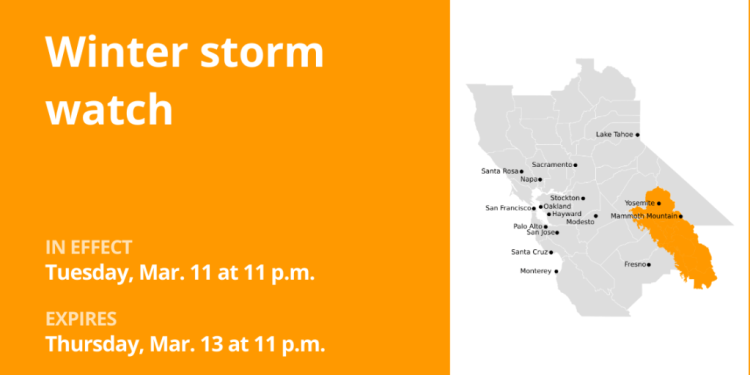Yosemite is included in a storm winter watch issued by the National Weather Service Sunday at 12:52 p.m. The watch is valid from Tuesday from 11 p.m. to Thursday March 13 at 11 p.m.
The NWS Hanford CA said: “The heavy snow possible. Total snow accumulations from 1 to 3 feet above 4000 feet and up to 4 feet on the highest altitudes. The winds could have a burst of 55 MPH. »»
“The trip could be very difficult to impossible. Dangerous conditions could have an impact on Wednesday morning and evening trips. Strong winds could cause damage to trees, ”said the NWS. “Monitor the latest update forecasts on this situation.”
The complete list of affected locations includes:
- Yosemite
- Yosemite valley
- Mariposa-Madera Lower Sierra
- Fresno-Tulare Lower Sierra
- Southern end of the lower sierra
- Canyon of the San Joaquin river
- Upper River of San Joaquin
- Kaiser in Rodgers Ridge
- Kings Canyon NP
- Grant Grove region
- Sequoia NP
- South end of Haute Sierra
Where to find winter weather shelters in your county:
Winter weather shelters in the County of Santa Clara: San Jose operates the night location program.
Winter meteorological shelters in the county of Alameda: list of winter shelters operated in the county of Alameda, health care of the county of Alameda for the homeless.
Winter weather shelters in the County of San Mateo: residents of the County of San Mateo who need a shelter should visit their local basic service agency to seek access to the weather program or other shelter programs.
Winter meteorological shelters in the Costa County County: for more information on how to connect with all emergency shelters at Costa, call 211 or click on the list of shelters provided by Contra Costa Health.
Winter meteorological shelters in Solano County: Solano County offers a list of centers where anyone can go warm during temperatures in extreme weather conditions.
Winter driving guide: NWS advice for safe travel and sound
Winter weather conditions can make driving treacherous, resulting in more than 6,000 deaths of bad weather and more than 480,000 injuries each year. When you travel during snow or freezing rain, prioritize safety by slowing down. In almost freezing temperatures, it is the surest to assume that freezing conditions exist on the roads and adjust your driving accordingly. Be careful of ice that accumulates on electric lines or branches of trees, which can cause the risks of snapping and falling. If possible, avoid driving in such conditions. If you have to venture, opt for routes with fewer trees and electric lines. Never touch a downstream electric line and immediately compose 911 if you meet one. Here are additional winter weather driving tips:
Share your travel plans:
When you venture out of the city in dangerous winter weather, be sure to inform the family or friends of your destination, your planned itinerary and your estimated arrival time.
Prepare your vehicle:
Make sure your petrol tank is full and equip your vehicle with essential winter supplies such as a windshield scratch, rider cables, a small shovel, a flashlight, a mobile phone, coverage, additional clothes, drinking water and non-perishable foods rich in calories.
Stay calm when you are blocked:
If you become blocked, stay composed. Inform someone about your situation and your location. Avoid trying to get to safety. Indicate that you need help by attaching a fabric to the antenna or mirror of your car, and make your vehicle more visible using the light and the indicators of the dome
Pay attention to snow plows:
Keep an eye on the snow plows and leave them amply for space to pass. Experience a plow only when you have a clear view of the coming road.
Check the road conditions:
Before you embark on your trip, consult the latest road conditions to make informed travel decisions.
Stay safe on winter roads with these precious NWS winter driving advice and reduce the risk of accidents in difficult weather conditions.
California Daily Newspapers


